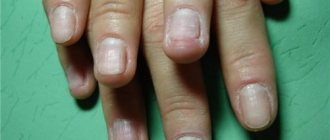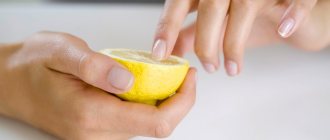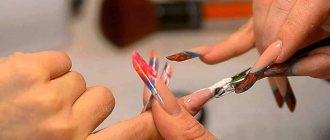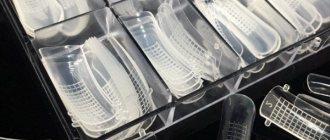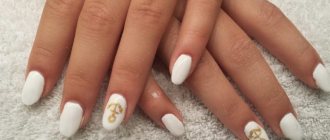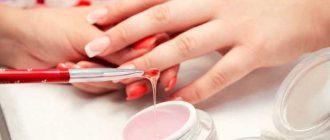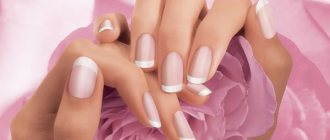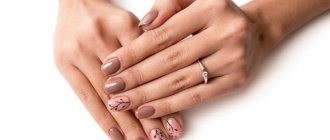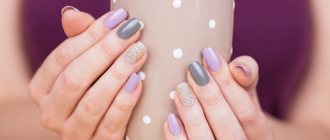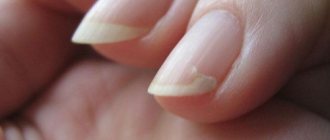Rating: No rating
Female representatives who strive to look well-groomed and beautiful in everyday life, as on any holiday, simply cannot ignore their hands . They often resort to the services of nail service specialists for such procedures as hygienic manicures, paraffin therapy and hand spa treatments, gel polish coating and nail extensions. Extension, in turn, implies timely correction. I would like to dwell in more detail on what correction of extended nails is and what needs to be taken into account if you use or plan to use such a service.
The specifics of such a procedure as correction of extended nails
Correction of extended nails usually involves a visit to a manicure salon. This is a rather lengthy procedure in which the missing material is added to the regrown part of the nail to give the manicure a neat, original look again. During correction, you can partially or completely change the design of your nails, as well as their shape and length.
There are two types of extensions: gel and acrylic. The specifics of working with these two materials have significant differences:
- to carry out gel extensions and corrections, a gel is used, which polymerizes in a UV lamp, and when working with acrylic, the master mixes two components - acrylic powder and monomer, which harden without additional equipment;
- the gel does not smell of anything , while the monomer, without which acrylic extensions are impossible, has a pungent odor, due to which it is contraindicated for people prone to allergies, asthma sufferers, and pregnant women;
- gel is a lightweight material , and when filing nails, gel dust flies into the air, acrylic is heavier than gel, and dust from it falls to the surface of the table;
- With the help of gel it is convenient to make aquarium designs and various color extensions, acrylic is not so transparent, similar options for nail art with acrylic extensions are also possible, but they do not look so impressive.
If for some reason you cannot make a correction in the salon, and the time to correct your nails has already come, you can carry out this procedure yourself at home if you have all the necessary materials for this.
How to correct extended nails
If you do not want to contact a specialist, and you are confident in your abilities, then you can restore your manicure yourself at home. You will definitely need to order or buy in the online store all the necessary materials and tools. Nail correction at home is justified from a financial point of view if you do it regularly. The main advantages of this solution are that you can make corrections whenever you want and help your friends.
Those who are interested in how to correct nails should first watch the lesson or read the step-by-step instructions with photos so as not to spoil the manicure. In addition to modeling material, you will need to purchase a UV lamp. To simplify the process, you can buy a manicure machine, the only drawback is that you need to learn how to use it and understand the sets of attachments. You don’t have to buy the most powerful router; you definitely don’t need a professional one. Its cost is relatively low, and you will use it for a long time.
- Clothes for Baby Bon
- Peanuts - harm and benefit. Beneficial properties for men and women, contraindications and peanut allergies
- DIY beaded flowers
Correction of extended nails with gel
This is one of the material options that is used for extensions and modeling. Correction of gel nails involves the use of specific materials that you will have to purchase yourself. For the procedure you need to have:
- degreaser;
- gel;
- modeling gel;
- liquid for removing the sticky layer;
- acid-free primer;
- antiseptic;
- cuticle oil.
This is the most minimal set for correcting extended nails with gel. If you used a single-phase gel for the first time, you can use it for correction. In the case of a three-phase procedure, any system is suitable. Next, you need to have a minimum set of tools that will help you do everything easily and quickly:
- lint-free wipes;
- buff for polishing nails;
- Ultraviolet lamp
- pusher or orange sticks;
- brushes for modeling nails with gel;
- gel files, suitable for 150/180 and 100/100 grit.
- nail clippers for cutting cuticles or blades;
- artificial nail clippers.
Below is a step-by-step description of how to correct gel-based nails. It is very similar to the procedure when working with acrylic. The instructions consist of the following steps:
- Degrease, disinfect hands, tools, remove varnish and paint from the plate (it is better to use products without acetone).
- Use an orange stick to lift the cuticle.
- Using a nail file, correct the shape, first file off those parts of the gel that have begun to lag behind. Then, in the place where the old coating begins at the cuticle, remove all the gel, you should get an imperceptible transition to the natural nail.
- Treat the surface with primer so that the infection does not get under the nail, remove excess with a towel.
- The smooth part of the regrown plate is cut off using a buff. Next, the hole is immediately filled with gel and dried with a UV lamp.
- When the material dries, you need to remove the sticky layer and form the correct shape. Use a file to immediately correct any unevenness, if any. The base layer of gel is applied evenly over all parts of the plate. A little more material is needed for the stress zone (just above the middle of the nail), but do not overdo it. Then dry the material again in a UV lamp.
- Then you need to correct the shape, smooth out defects and unevenness using a nail file. Be careful not to accidentally wear off the base layer to the old coating.
- Remove dust regularly with a brush.
- Before applying the finish, you need to make the desired design (drawing, French).
- Next, apply the finishing coat in one layer and dry under a lamp. To make it smoother, then apply a buff.
- You need to treat the side rollers and cuticles with nourishing oil (rub in like a cream).
Correction of acrylic nails
This type of artificial material is very popular among girls. Correction of nails with acrylic is carried out according to a similar algorithm, as with the option described above. To ensure everything works out correctly, you can use the instructions described below:
- Treat your hands and work surface with a disinfectant.
- Remove the varnish layer with a non-acetone product.
- Treat cuticles with a softening agent. After 2 minutes, use a wooden stick/spatula to remove the pterygium from the natural plate.
- Remove any remaining product using a lint-free cloth. File down the free edge with a nail file and set the desired shape. It is necessary to cut down 2/3 of the thickness of the material.
- Remove shine from the natural nail for better adhesion of the plate to the acrylic.
- Treat the peeling areas with a fine-grain nail file.
- Next, you need to treat the part where there is no acrylic using a degreaser.
- Treat the nail plate with a primer, which connects the keratin of the natural part with the artificial material.
- Run the simulation. Make sure that the acrylic is applied evenly over the entire area and does not penetrate the skin or into the lateral sinuses. Extension brushes should only be made of natural bristles; do not press too hard when applying.
- Then place your hands under a UV lamp for 2.5 minutes.
- Apply special oil to the cuticle.
Nail correction with shellac
This is a new type of coating that is easier to apply and lasts as long as gel/acrylic ones. Nail correction with shellac is carried out in two ways: with or without complete removal. To carry out the procedure, a standard set of instruments is used. Correction of gel polish is carried out according to the following instructions:
- It is recommended to treat nails that are too dry using a special activator. it consists of essential oils and water, apply it to the sides and keep for 5 minutes.
- Use a pusher to pick up the shellac polish. Carefully remove the coating; this is easier to do using the same activator.
- Using a nail file, give the regrown edge the required shape.
- Next, get a manicure or use a special gel to soften the cuticle and push it back.
- Clean the plate with a nail polisher until a shine appears. This step cannot be skipped; then it will be easier to remove the layer if necessary.
- Degrease the surface.
- Coat the substance that replaces the base and finish, dry it under a lamp.
- Select a shade of shellac, apply one layer to the surface, and dry.
- Then another layer, and again you need to dry it.
- Apply finishing coat last and let dry.
- Apply cuticle repair serum.
Nail correction using tips
This procedure is similar in its algorithm to working with gel extensions. Restoring sealing, updating the coating, replenishing modeling materials, giving an aesthetic appearance - all this is the correction of nails using tips. Below is an algorithm for acrylic technology:
- Saw off the overgrown tips with a reversible nozzle and process to a thin substrate.
- File the surface of the nail with a 180 grit file, smooth out the transition from the tip to its own plate.
- Use a spatula to push back the cuticle.
- Use a diamond attachment to perform a hardware manicure.
- Degrease, disinfect the nail, wipe with a napkin (dry).
- Apply a small amount of acid-free primer at the base of the tip.
- Lengthen the nail bed with camouflage acrylic and shape using a brush.
- Model the cuticle growth area and apex with matte, one-time powder.
- Next, you should compress the stress area.
- Use a clothespin to secure the clamp.
- Model the free edge of the nail with white acrylic. You can put it on two tips at once.
- Form the free edges with the base of a thick brush.
- Use the drum attachment (reversible) to file the tip of the nail.
- Treat the inner, longitudinal arch in the same way.
- File the cuticle and apex area with the “corn” attachment.
- Use a 100 grit file to file down the nail plates.
- Sand the inner arch of the nail using the reverse corn attachment.
- Use a carbide tip to treat the hyponychium area (where the inside of the nail comes into contact with the skin).
- Treat the outer and side parts with a 100 grit file and remove dust.
- Coat the inside of the loose tips with finishing gel without sticky salt.
- Cover the outside with gel too.
- Keep your hands under the UV lamp for 2 minutes.
What is needed to correct extended nails with gel?
To correct extended nails with gel, you need the following materials :
- milling machine (at home you can replace it with a nail file);
- soft brush for removing nail dust;
- brush for gel extensions;
- degreaser;
- file and buff;
- Ultraviolet lamp;
- Siller;
- colored or transparent gel (depending on what the extension was originally);
- a paper napkin to wipe the brush;
- lint-free wipes;
- cuticle oil;
- primer;
- clinser.
When correcting nails, use a file for extended nails with a coarse abrasiveness of 80-100 grit. It is suitable for both gel nails and acrylic nails.
Step-by-step instructions for correcting extended nails with gel at home with photos
By following these instructions, you will learn how to correct extended nails with gel step by step at home and will be able to carry out the procedure yourself. Before you begin, treat your hands with an antiseptic, soften and remove the cuticle in a way convenient for you . Further actions require accuracy and lack of haste.
- Using a nail file or a router remove the shiny layer of sealer from the previous coating from the nails, file the nails, adjust their shape and length so that there are no peelings left. Buff each nail with a buff. Remove nail dust with a brush.
- Degrease the overgrown part of the natural nail, then apply primer to the entire length of your nails.
- Brush apply gel to your nails from the cuticle area to the free edge in a very thin layer. Dry in the lamp for 2 minutes. Repeat this step and remove the sticky layer with a lint-free cloth and cleanser.
Do not forget to wipe the brush on a napkin while working with the gel. Make sure that it is not exposed to ultraviolet light. - Adjust the surface of your nails file and buff, taking care not to damage the shape.
- Cover your nails with finishing sealer and dry in a lamp for 2 minutes.
- Use oil for the cuticle.
At this stage, the correction of gel nails is completed . If desired, you can complement the result with a beautiful design.
How to correct extended nails with acrylic
Correction of acrylic nails is carried out according to the same principle as gel nails. The main difference is the application of the material itself and a special brush for working with acrylic. The brush is moistened in monomer, previously poured into a small glass container, then acrylic powder is collected. This mixture is distributed over the nail plate.
This material does not require additional drying devices; it hardens in air without any manipulation. Taking this fact into account, you need to work quickly with acrylic powder and monomer , and the brush must be regularly cleaned of material residues while working, otherwise it will become unusable after the first correction.
You will still need a UV lamp to dry the topcoat with sealer. This step should not be skipped, since the sealer, in addition to shine, also serves as a fixative that can increase the wear time of the manicure.
Correction of extended nails using tips
Typically, flexible forms with a sticky base are used for nail extensions, but tips are also sometimes used. They are glued to the natural nail with special glue and serve as a more stable substrate for the further extension procedure.
When working with tips, use only special glue for tips! Using any other glue can seriously damage your nail!
Masters use tips in cases where the client’s nails are too short or their natural shape does not allow the use of conventional flexible forms. Before starting the procedure, each tip needs to be adapted to your nail , since initially they all have a standard length and shape. When gluing tips, you need to press them tightly against the surface of a previously degreased natural nail so that during further use there are no peelings or chips.
Also an obligatory step is filing the finished substrate with a hard buffer - without this, the material will not stick due to the glossy surface of the tips. After the base is ready, gel or acrylic is applied on top of the tips, giving the nails the most natural look possible and applying the finishing coat . It is worth considering that a French jacket made on tips cannot be adjusted; it will need to be redone.
Correction of acrylic nails
Before correcting extended nails with acrylic, it is important to prepare all the tools :
- File with coarse grain (wide, optimally 100x100);
- Cap for monomer (a product is collected into it to avoid overconsumption);
- Powder;
- Degreaser, primer;
- Acrylic;
- Brushes and pipette.
You can use regular alcohol or any alcohol-based tonic as a degreaser - they have the same functions. Also, before correction, the old varnish is removed and the nail is slightly filed.
Nail correction and extension set for beginners
Step-by-step instructions for beginners with a video on how to correct nails with acrylic:
Video: Correction of gel nails (nail design lessons)
- The cuticle is moved to the very bottom of the nail, after which the filing is made. The technology is the same as for extensions. From the cuticle down to the hole, the file moves in a circular motion. This is necessary because the plate grows unevenly. The goal is to equalize the old acrylic to the level of the natural surface;
Removing old acrylic material - Next, a quick cleaning is carried out to remove the characteristic deposits after sawdust. A napkin, brush or towel is suitable for this;
- As when working with biogel, first the surface of the nail is degreased. Afterwards, a primer is applied to the dried plate;
- Now take a capsule for the monomer and the acrylic itself. Using a pipette, the required amount of product is collected. Next, a brush is dipped into the capsule; first it needs to be well moistened with acrylic. Afterwards, everything unnecessary is brushed onto the walls of the container with monomer;
Set of powder for brush with acrylic - A small amount of acrylic is collected on the tip of the brush, then it is lowered with the same tip into the powder and a ball is collected on it in a circular motion;
- The resulting ball must be distributed very quickly and evenly over the plate;
Stretching an aryl ball - When distributing the powder, special attention is paid to the place where there is a seam between the old acrylic and the natural plate. The brush is slightly pressed into this area;
- Before each next layer, be sure to wipe the brush on a napkin so that there is nothing unnecessary on it;
- Correction with acrylic is most often carried out on tips. To do this, you need to attach the form to the plate and select the desired length according to it. It needs to be placed under the nail and completely adjusted to the shape - so that there are no gaps or sharp transitions;
Forming an acrylic plate - The acrylic in the capsule is replaced and correction work is resumed. The system is the same as before. The brush is soaked in monomer and then dipped in powder. The product is applied over the staples;
Fixation tips - All that remains is to dry your nails and paint them. You can make bright long claws with plates or, conversely, a flirty French correction of extended nails.
Acrylic extensions with gel coating
Many modern ideas for correcting acrylic nails include the use of gel polish. Outwardly it looks very natural (if the correct length and shape are chosen).
How long does it take to correct extended nails?
The question about the frequency of the procedure for adjusting extended nails suggests itself, but no one can give a definite answer. It all depends on how quickly your nails grow , how brittle they are, and whether you use gloves when doing housework. Also, your profession and place of work, as well as the household chemicals you use, play an important role in wearing extended nails.
On average, it takes three weeks from extension to correction. If your nails do not grow too quickly, if you wear them carefully, you can wear extended manicure for a little longer. If your nails are naturally weak and brittle, or the conditions of the work you perform do not have the best effect on their condition, you may have to resort to correction more often . Everything is very individual, by doing extensions for a certain amount of time, you will determine the optimal period for wearing nails until the next correction and will focus on it during subsequent appointments at the manicure salon.
The extension procedure is popular and in demand. When growing your nails, you should immediately think about the fact that after some time they will grow and will need to be adjusted. To do this, you don’t have to go to the salon, now you know that correction of gel and acrylic nails is possible at home, you just need to be patient, and everything will work out!
Types of nail correction with gel
Each master carries out this procedure differently. It all depends on the condition of the surface and the applied design. There are several common options:
- Small gel correction. Repairs are carried out only on damaged areas where there is peeling or cracking. This requires a minimal amount of time and money. The photo below shows the condition of the nail requiring such treatment.
The photo was taken before correction.
- Average correction. Thanks to this manipulation, you can hide the area of the overgrown nail plate.
- Big correction. The procedure resembles a new extension process. The master will be able to change the design or form a different shape.
